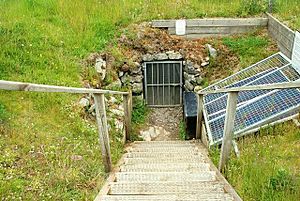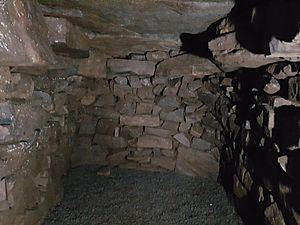Finnis souterrain facts for kids
The Finnis souterrain, also called Binder's Cove by local people, is an amazing underground tunnel system. It's found in Finnis, a place south of Dromara in County Down, Northern Ireland. This special site is made of drystone, meaning the stones are fitted together without any mortar. It's a protected historical place and one of the few souterrains you can actually visit!
Contents
What is the Finnis Souterrain Like?
The Finnis souterrain has a main passage that is about 30 meters (almost 100 feet) long. This passage runs from east to west. There are also two shorter passages, each about 6 meters (20 feet) long, that branch off to the right. These side passages lead to small rooms. All three passages are about 1 meter (3 feet) wide.
The first part of the main passage, about 7.5 meters (25 feet) long, is only about 1 meter (3 feet) high. After that, you'll find a low stone beam, called a lintel. The passage then gets a bit taller, about 1.5 meters (5 feet) high, and curves slightly downwards.
How Was It Built?
The walls of the souterrain are made from granite stones. They were built using a special method called dry stone construction. This means the builders carefully stacked the stones without using any cement or mortar to hold them together. The roof is made of flat stones, called lintels, that stretch across the top of the walls.
The entrance you use today is not the original one. No one knows exactly where the first entrance was or when the current one was made. We do know that an iron door was put there in 1833 by the local church leader, called a rector. Some people think the main passage might have gone even further east than the current entrance. An old description from 1836 even mentioned stone steps, but these have never been found.
Why Was the Finnis Souterrain Built?
The Finnis souterrain was first built a very long time ago, in the 9th century. People have known about it since at least the early 1700s. While experts aren't completely sure about the exact reason for souterrains, they have some good ideas.
One idea is that these underground tunnels were used as a safe place. People might have hidden there from raiders or invaders who attacked their homes. Another idea is that they were used to store important religious items. Because souterrains are usually dry and cold, they were also perfect for keeping food fresh.
How Was the Souterrain Restored?
In 1977, archaeologists looked at the site, but they didn't dig it up completely. Later, work began to fix up the souterrain and open it for people to visit. This project was a team effort between the person who owned the land and the local council, Banbridge District Council.
Money for the restoration came from several groups, including the Mourne Heritage Trust, the Environment and Heritage Service, and the Northern Ireland Tourist Board. During the work, dirt that had built up inside was removed. Some small repairs were made to the stone walls. Stone chippings were put on the floor to make it easier to walk. Solar-powered lights were added along the passages to help visitors see. The old iron door was also replaced.
Outside the souterrain, a fenced path was built along the edge of the field, and an information board was placed near the entrance. All the work was finished, and the Finnis souterrain officially opened to the public in July 2003.



